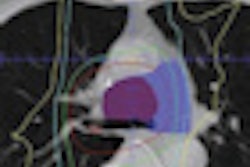
Opportunity and risk. Risk and opportunity. Januslike sides of the same coin. Of course, the greater the opportunity, the greater the risk.
In a medical practice sense, radiologists are surrounded by risk. For example, the diagnosticians among you clearly understand the malpractice risk inherent in your interpretations, and the interventionalists certainly are cognizant of the risk-reward analysis made by your patients in undergoing procedures.
 |
| Healthcare business and legal affairs expert Mark F. Weiss. |
But many radiologists are oblivious, or even adverse, to the risk-reward duality in a business sense as it affects their radiology group.
In the group business context, success -- that is, opportunity -- is associated with the income side of the equation: increasing realized income per procedure, increasing the number of well-reimbursed procedures, and increasing the amount of hospital stipend dollars received.
Radiology groups are generally less affected by the risk, or expense, side of the equation. But note the word generally, because it fails to take into account the enormity of the impact on the group of an adverse event -- an essential step in risk analysis. It's a mistake to assume that the probability of an event is the same as its risk: Both the probability of an event and the severity of its potential impact must be estimated to properly assess risk.
For example, returning for a moment to the medical practice, as opposed to business, context, even though one might believe that a malpractice claim is a rare occurrence, the enormity of a potential adverse award drives most physicians to carry malpractice insurance.
Business side risk is inherent in any radiology group. It exists within the group itself as well as from outside sources. And, it's a fallacy to believe that business risk can be avoided. It can only be managed.
Let's look at several examples of radiology group business risk and the ways that it can be managed.
Your group's services are no longer needed
Despite the fact that your group has been providing services pursuant to an exclusive contract with St. Mark's Community Hospital for years, the hospital's CEO has been seen giving a guided tour of the facility to the leader of a competing group.
The next thing you know, the CEO is mumbling about sending out a request for proposal (RFP) instead of simply starting the usual contract renewal negotiations.
You may have believed that the probability of nonrenewal is low, but if the result is the mooting of your group's existence and the need for each of your group members to find new positions (and possibly sell their homes and find new schools for their children), the "cost" could be extremely high.
What proactive steps has your group taken over the years to maximize referring physician support, to provide a level of service that cannot be duplicated, to "burrow" yourselves so deeply within the hospital's operation that replacing your group would wreak havoc on the core operation of the hospital?
What steps has your group taken to ensure that it has an existence beyond simply providing services at St. Mark's? If the answer is "nothing," what alternatives do your group's members have in the event that the contract with St. Mark's is not renewed?
Note also that these latter steps also apply in two other related risk situations: the risk of St. Mark's closure and the risk that St. Mark's imposes a staff model solution in which your group's physicians are not invited or do not wish to participate.
I deserve to be a partner
Dr. Smith has been providing services through your group for five years as a subcontracted radiologist. He has done all assigned cases, has never caused any trouble, and is regarded as a highly competent physician.
Your group has been in existence for 15 years. You and each of your partners devote substantial time to administrative duties in addition to full caseloads. Each has invested significant sums in the group to get it though past cash-flow crises.
Dr. Smith announces that he "deserves" to be a partner and should be admitted to the partnership without any or perhaps only a token buy-in. He either does not understand or he purposefully ignores the business risk that you and your partners took in forming the group and continue to take in respect of its operation.
On the other hand, the group's organizational documents do not contain any partnership protection language -- to the contrary, Dr. Smith asserts that the language of his subcontract makes him the owner of his own independent practice and claims that "his accounts receivable" are indeed his, and that he will "take them" if he is not made a partner.
How has your group coordinated its organizational documents and its agreements with employed and subcontracted physicians to minimize this risk?
The imaging center is my own deal
Dr. Jones is a shareholder in your group. For the past several years, she's been scheduled by the group to cover a slot at an imaging facility in a neighboring town that generates significant collections for the group.
Dr. Jones now announces that she is leaving your group and that she will be covering that facility for her own account.
What steps has your group taken to control or prohibit competition? If covenants not to compete are enforceable in your state, have you utilized them? If they are not, have you implemented CNTC proxy techniques in your group's agreements to dissuade competition?
You've mismanaged the group, so give me my $500,000
As the senior partner of your group, you've been in charge of its business operations for many years.
Despite the growing Medicaid and Medicare populations in your main facility's service area, you've been able to expand the group's business to other facilities and have advanced the group members' compensation.
Nonetheless, two of your partners claim you have mismanaged the group -- had you managed it "properly," the group's profits would have been significantly higher and those profits would have increased partner distributions. They sue.
Your group has obtained malpractice coverage for each of its doctors, has purchased entity coverage from your malpractice carrier in respect of claims against the group itself, and has even purchased general liability coverage insuring the group against third-party property damage and bodily injury claims.
But has your group obtained directors and officers (known in the insurance industry as "D&O") coverage?
D&O insurance protects directors and officers -- and in the context of a partnership, its managing members -- from liability arising from actions connected to those positions. Different forms of D&O exist to expand coverage beyond the basic level. For example, some D&O policies provide employment practices liability coverage protecting against employment related claims such as wrongful termination and sexual harassment.
Also, has your group placed limitations on liability, forum selection provisions, and, potentially, arbitration provisions in its partnership-shareholders agreements and agreements with employed or subcontracted personnel?
In conclusion
Risk cannot be avoided because it goes hand in hand with opportunity.
Although risk can never be eliminated, it can be managed.
Successfully managing risk requires that you take a proactive approach. Although some elements of risk can be managed after the event, you're strongly advised to engage in the proper strategizing and implementation far in advance.
By Mark F. Weiss
AuntMinnie.com contributing writer
August 13, 2010
Mark F. Weiss is an attorney who specializes in the business and legal issues affecting radiology and other physician groups. He holds an appointment as clinical assistant professor of anesthesiology at University of Southern California's Keck School of Medicine and practices nationally with the Advisory Law Group, a firm with offices in Los Angeles and Santa Barbara, CA. Mr. Weiss provides complimentary educational materials to our readers. Visit www.advisorylawgroup.com for his free newsletter. He can be reached by e-mail at [email protected].
Related Reading
The Profit Center: Part 14 -- Accountable care organizations: Accountable to whom? June 10, 2010
The Profit Center: Part 13 -- Radiology as factory work? April 13, 2010
The Profit Center: Part 11 -- Thriving despite (so-called) healthcare reform, January 13, 2010
The Profit Center: Part 10 -- Taking on risk with dubious reward, January 4, 2010
Copyright © 2010 Mark F. Weiss



















